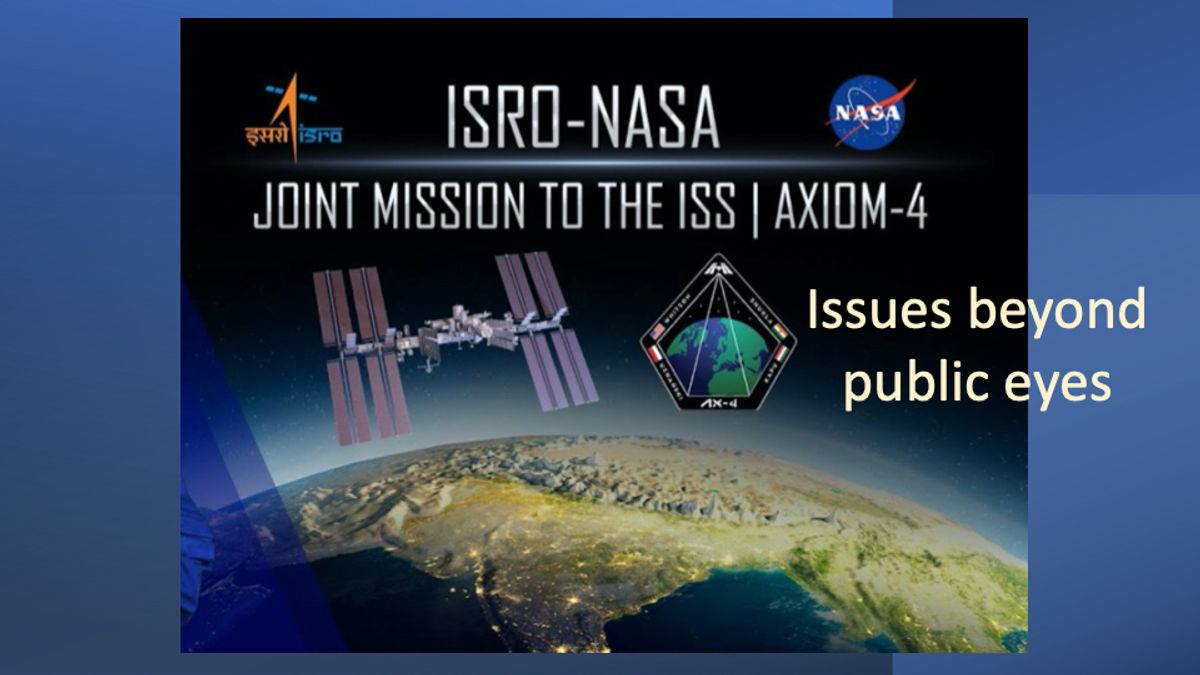
Dissecting Axiom-4 Flight to International Space Station (ISS)
ISRO-NASA Joint Cooperation to ISS
During the visit of PM Modi to USA in Jun 2023, it was agreed that ISRO-NASA will undertake a joint Human Space Mission to the International Space Station (ISS) in 2024-25 in a G2G appreciation. Like Indian National Space Promotion and Authorisation Centre (IN-SPACe), NASA facilitates its launches thru’ Axiom which coordinates with private human flight launch services of SpaceX. An MoU was signed in which NASA would train two astronauts for piloting, mission Op and Human-Computer Interface (HCI)…all very important features of Human Space Mission. People may like to know that SpaceX Crew-Dragon is fully computerized for all its functions from being injected into Earth orbit to its docking. However, astronauts are always in the HCI loop to take over the limited controls under emergencies not well handled by the computers. Further, if India has to meet its future aspirations of Bhartiya Space Station (BSS), these crew experience would be of immense importance. India had to bear some cost of the trip to the ISS amounting Rs 548 Cr ($64 Mn). The usual price tag for each seat on SpaceX for the to & fro travel to ISS ranges from $55 Mn- $80 Mn.
The Lift-Off
After initial hiccup of launch schedule postponed from 29 May to 8 Jun, to 10 Jun to 20 Jun to 25 Jun, the SpaceX Falcon-9 rocket with Crew Dragon module finally lifted off on 25 Jun and inserted the Crew Dragon into lower Earth Orbit at ~200 Km altitude in ~22 min separating from 2nd stage. In the next ~28 hrs its altitude was raised to ~400 Km finally docking with the ISS on 26th Jun 25. You may be surprised to know that Russian Soyuz takes Human Crew module to their ISS docking in just 5 hr 4 min from lift-off but the reason is of difference in their docking points (read “Shortest Travel Time to ISS”, https://thecounterviews.in/articles/shortest-time-leo-orbit-iss-docking-russia-spacex-international-space-station/).
Team Axiom-4 is scheduled to stay there for a fortnight before undocking, deorbiting and splash down into the bay of Mexico. From deorbiting at ~400 Km above Earth to splashdown in the Sea, it takes precisely ~16 min incl the communication blackout phase of ~ 2 min during the re-entry phase when temp surrounding the crew module will be in the vicinities of plasma. All remaining time of returning back goes in various preparatory checks, de-coupling from the docking port, separation from ISS and positioning to the point from where deorbiting burn has to be initiated.
SpaceX has developed a very sophisticated infrastructure to track down their Crew Dragon during the entire phase and rescue the crew within minutes of splashdown. After longer missions, there are structured rehabilitation period for the crew.
Relevance to Gaganyaan and Bhartiya Space Station
Many people are questioning why this joint ISRO-NASA mission was added to Gaganyaan, the answer is simple, ISRO during their 2019 announcements of sending the Human Space Flight in 2021 had miscalculated the intricate technological aspects that are yet to be perfected; further complicated by Covid Pandemics hurdles. They had not visualized the Human Rating of launch vehicle as well as certification of numerous many systems of Env Control and Life Support Sys (EC&LSS), a mandatory requirement. There were some additional roadblocks for ISRO that skipped roving eyes & lenses. Precious crews were prematurely sent to France and Russia for training after which they sat idle for years for want of a Human rated launch system. Meanwhile, there were some changes of plans in the finalizing of the actual Crew Module Systems that necessitated another set of training in ISRO. The present venture was mooted as ISRO possibly wanted some more insight into system hardware engineering, HCI as well as mission planning. Putting the astronauts in the loop of computerized automation amidst remote operations during emergencies, is a tricky issue and gaining insight at the NASA-SpaceX will be highly beneficial. Carrying out tests & experiments were possibly aimed at developing a test bench for the BSS experiment module.
ISRO’s Gaganyaan mission is a much simpler task in which LVM3 will inject the Crew module into a Low Earth Orbit at 51.5 deg inclination, at 400 Km altitude for 3 days. It is rather an intricate decision because ISS too will be around the same path at similar altitude. Even Chinese Space Station could be close by at 389 Km altitude but at a different inclination having a remote possibility of close pass by. Unless planned with deliberate objectives, the first Gaganyaan flight could have been planned with a simpler objective for a brief period at lower altitude. Anyway, that is an executive decision that cannot be countered. Gaganyaan crew module is a smaller volume vessel without separate place for toilets, privacy or rest/exercise and dining.
As it was apparent from the nationwide telecast of PM Modi’s interactions with Gp Capt Shubhanshu Shukla, most of his questions pertained to how his experience of training, launch, docking, habitat at ISS, carrying out experiments etc will help Indian Space programs in future incl those in BSS. The reply of Gp Capt Shukla was unambiguous in saying that all these exposures will prove to be some sorts of cornerstones for the future Indian Human Space Missions. He also mentioned that he is keenly observing the activities at ISS so as to carry as much of takeaway as possible.
Some reports mention the price tag of Axiom-4 mission as excessive which is not the case. It is very meagre amount for the type of task that included the astronaut training of two crew, main and standby Gp Capt Subhanshu Shukla and Gp Capt Prashant Nair. Even USSR mission involved two crew, Sqn Ldr Rakesh Shukla (main) and Wg Cdr R Malhotra (standby). However, very few people know that both SpaceX and ISRO system technologies are almost entirely different. Training on SpaceX system doesn’t ensure a trained approach on Gaganyaan. In fact, it is quite possible that the astronauts may have to unlearn the SpaceX training before undertaking Gaganyaan mission. However, as ISRO technologies gradually mature with more sophistications and automations, a broad concept may be similar in approach…BUT…that is for the distant future. Remember, when Chinese sent its first Human Space Flight, astronaut Yang Liwei before his 21 hr maiden flight, he was neither trained in USA nor in Russia.
Looking back, it is always easy to question the decisions of those who entered the MoU with NASA-SpaceX but frankly speaking, those decisions may turn out to be the cornerstones of the future Indian Human Space Missions. Gp Capt Subhanshu Shukla is expected to be observant enough as to what sort of design concepts could be adopted to make BSS even more efficient and elegant as compared to ISS. He will now realise the operational intricacies as to why Sunita Williams and Buch Wilmore were left stranded for such long period for want of a return vehicle.
Onboard Experiments
As far as the experiments and tests assigned on Axiom-4 mission are concerned, some of these are more of getting familiar with scientific experiments than expecting any short-time scientific breakthrough. However, line of thought for future scientific experiments in BSS are on right track. The list of experiments to be carried out by the Indian astronauts are placed below:-
- Bio-Agri research of microgravity on Micro-Algae, Cyanobacteria, Sprouting of Salads and growth & yield of food crop seeds, myogenesis under food supplement…all experiments designed by reputed institutions.
- There are two other highly specific but long-term experiments from IISc.
The media hypes on these experiments are uncalled for. It can be expected that many such similar experiments would have been undertaken by some or the others in the past numerous missions abord many space stations…be it Salute, Mir, Space Shuttles or the others. Nevertheless, conceptualization, adopting the procedure under simulation, collaborating with NASA-SpaceX in sending the testbeds to the ISS and then collecting the data under actual microgravity are all series of learning process. In future, planning and execution of manufacturing under microgravity could be a pathbreaking approach. There is also an urgent need to keep pace with leading military powers in the application of space technologies or space platforms in combat theatres.
The Bottom-Lines
Astronaut training of both Gp Capt S Shukla (main) and Gp Capt P Nair (Standby) are considered to be a major experience gainer for all future Indian Space Missions even though Indian Space Veh is going to be entirely different from those of SpaceX. Visit to the ISS and carrying out experiments will provide an important input in the designing of Experiment module & test platforms for the BSS. ISRO and Govt of India is thinking on right lines after the dampeners faced in the preparations prior to Gaganyaan mission. For India to exploit the space technologies and applications to the fullest, experience gained by the present set of crews must be utilized in in the BSS spacecraft design and the HCI. All types of opportunities available in space applications must be exploited to the fullest in all fields incl defence.
